Related Research Articles
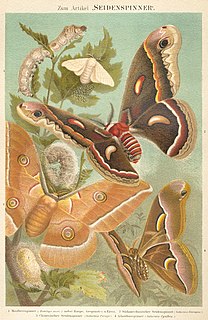
Silk is a natural protein fiber, some forms of which can be woven into textiles. The protein fiber of silk is composed mainly of fibroin and is produced by certain insect larvae to form cocoons. The best-known silk is obtained from the cocoons of the larvae of the mulberry silkworm Bombyx mori reared in captivity (sericulture). The shimmering appearance of silk is due to the triangular prism-like structure of the silk fibre, which allows silk cloth to refract incoming light at different angles, thus producing different colors.
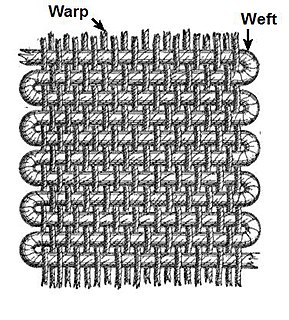
Weaving is a method of textile production in which two distinct sets of yarns or threads are interlaced at right angles to form a fabric or cloth. Other methods are knitting, crocheting, felting, and braiding or plaiting. The longitudinal threads are called the warp and the lateral threads are the weft, woof, or filling. The method in which these threads are inter-woven affects the characteristics of the cloth. Cloth is usually woven on a loom, a device that holds the warp threads in place while filling threads are woven through them. A fabric band that meets this definition of cloth can also be made using other methods, including tablet weaving, back strap loom, or other techniques that can be done without looms.
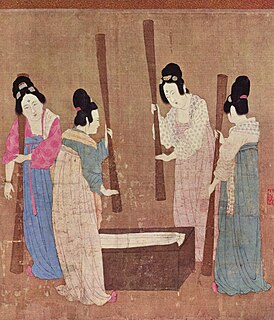
Sericulture, or silk farming, is the cultivation of silkworms to produce silk. Although there are several commercial species of silkworms, Bombyx mori is the most widely used and intensively studied silkworm. Silk was believed to have first been produced in China as early as the Neolithic Period. Sericulture has become an important cottage industry in countries such as Brazil, China, France, India, Italy, Japan, Korea, and Russia. Today, China and India are the two main producers, with more than 60% of the world's annual production.

Khadi, derived from khaddar, is a hand-spun and woven natural fibre cloth promoted by Mahatma Gandhi during freedom struggle of the Indian subcontinent, 'Khadi' term is used throughout India, Pakistan and Bangladesh. The first piece of the hand-woven cloth was manufactured in the Sabarmati Ashram during 1917-18. The coarseness of the cloth led Gandhi to call it 'khadi'. The cloth is usually hand spun and woven from cotton. However, it may also include silk or wool, which are all spun into yarn on a spinning wheel called a charkha. It is a versatile fabric, cool in summer and warm in winter. In order to improve its looks, khādī/khaddar is sometimes starched to give it a stiffer feel. It is widely accepted in various fashion circles. Popular dresses are made using khadi cloth such as dhoti, kurta, and handloom sarees such as Puttapaka Saree, Kotpad Handloom fabrics, Chamba Rumal, Tussar silk etc. Gajam Anjaiah, an Indian master handloom designer and a recipient of the Padma Shri, is known for his innovation and development of tie-dye handloom products along with the Telia Rumal technique of weaving products based on the Ikat process.
Longcloth refers to a plain cotton cloth originally made in comparatively long pieces.

The Provinces of India, earlier Presidencies of British India and still earlier, Presidency towns, were the administrative divisions of British governance in the Indian subcontinent. Collectively, they have been called British India. In one form or another, they existed between 1612 and 1947, conventionally divided into three historical periods:

Rahon is a city and a municipal council in the district Shaheed Bhagat Singh of the Indian state of Punjab. Rahon is in Doaba region of Punjab. Doaba also known as Bist Doab, is the region of Punjab, India that lies between the Beas River and the Sutlej River. A famous battle was fought here between Sikhs and Mughals i.e Battle of Rahon (1710).
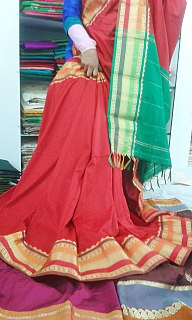
Rajshahi silk is the name given to the silk products produced in Rajshahi, Bangladesh. It is famous because it is a high quality fabric used for clothing, especially for saris. In 2021, it was given Geographical indication status as a product of Bangladesh.

Silk in the Indian subcontinent is a luxury good. In India, about 97% of the raw mulberry silk is produced in the Indian states of Karnataka, Andhra Pradesh, Tamil Nadu and West Bengal. Mysore and North Bangalore, the upcoming site of a US$20 million "Silk City", contribute to a majority of silk production. Another emerging silk producer is Tamil Nadu where mulberry cultivation is concentrated in Salem, Erode and Dharmapuri districts. Hyderabad, Andhra Pradesh and Gobichettipalayam, Tamil Nadu were the first locations to have automated silk reeling units.
Assam silk denotes the three major types of indigenous wild silks produced in Assam—golden muga, white pat and warm eri silk. The Assam silk industry, now centered in Sualkuchi, is a labor-intensive industry.
Gomastha described an Indian agent of the British East India Company employed in the Company's colonies, to sign bonds, usually compellingly, by local weavers and artisans to deliver goods to the Company. The prices of the goods were fixed by the gomasthas. The goods were exported by the Company to Europe. Earlier supply merchants very often lived within the weaving village, and had a close relationship with the weavers, looking after their needs and helping them in times of crisis. The new gomasthas were outsiders with no long-term social link with the village. They acted arrogantly, marched into villages with sepoys and peons, and punished weavers for delays. The weavers thus lost the space to bargain and sell to different buyers; the price they received from the Company was miserably low and the loans they had accepted tied them to the Company. A gomastha may also be described as ‘a paid manager of the private trader’s concerns’, who claimed ‘hardly any share in the profit and loss of his employer’s business’.
Silk waste includes all kinds of raw silk which may be unwindable, and therefore unsuited to the throwing process. Before the introduction of machinery applicable to the spinning of silk waste, the refuse from cocoon reeling, and also from silk winding, which is now used in producing spun silk fabrics, was nearly all destroyed as being useless, with the exception of that which could be hand-combed and spun by means of the distaff and spinning wheel, a method which is still practised by some of the peasantry in India and other countries in Asia.
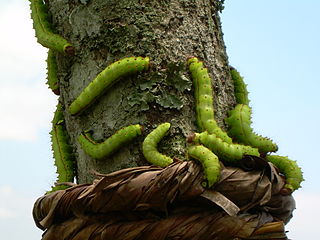
Wild silks have been known and used in many countries from early times, although the scale of production is far smaller than that from cultivated silkworms. Silk cocoons and nests often resemble paper or cloth, and their use has arisen independently in many societies.

Tussar silk is produced from larvae of several species of silkworms belonging to the moth genus Antheraea, including A. assamensis, A. paphia, A. pernyi, A. roylei, and A. yamamai. These silkworms live in the wild forests in trees belonging to Terminalia species and Shorea robusta, as well as other food plants such as jamun and oak found in South Asia, eating the leaves of the trees on which they live. Tussar silk is valued for its rich texture and natural, deep-gold colour, and varieties are produced in many countries, including China, India, Japan, and Sri Lanka.
Yūki-tsumugi (結城紬) is a variety of silk cloth produced in Japan, chiefly in Yūki in Ibaraki Prefecture. It is designated as one of the Important Intangible Cultural Properties of Japan, and has also been inscribed on the UNESCO Representative List of the Intangible Cultural Heritage of Humanity.
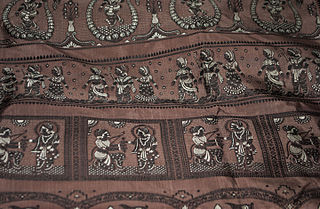
Baluchari Sari is a type of sari, a garment worn by women in Bangladesh and Indian States of West Bengal. This particular type of sari originated in West Bengal and is known for depictions of mythological scenes on the pallu of the sari. It used to be produced in Murshidabad but presently Bishnupur and its surrounding areas of West Bengal are the only place where authentic Baluchari saris are produced. It takes approximately one week to produce one such sari. In 2011, the Baluchari Sari was granted the status of Geographical Indication for West Bengal in India.
Gulbadan was a kind of striped silk produced in Hindustan. The gulbadan was a light textured cloth of silk and cotton. Gulbadan has vertical variegated stripes with a different color than the base color of the cloth. In appearance, it was similar to a glazed calico, unlike Mashru, which has the satin (lustrous) surface.The contemporary silk piece goods were Daryai and Dhupehan. Gulbadan was available in many color combinations and sizes. Gulbadan of Amritsar and Lahore were famous. "Sufi" was another name for Gulbadan striped fabric.
Gaji is a coarse cloth mainly made with cotton or silk, used for native dresses in India.
Dorea was a type of striped or check patterned cloth made in the Indian subcontinent. The continued striped Dorea was a simplest form of Dorea.
Garbhasuti was a mixed cloth of tussar silk and cotton produced in Bengal. It was a handwoven material in the 19th century, Manbhum and Bankura produced most of it. Garbhasuti was a common name for fabrics with a cotton warp and a silk weft. Typically, it was ten yards long and one yard wide, which cost Rs. eight per piece. More often Garbhasuti was a made-to-order material.
References
- 1 2 Mukerji, Nitya Gopal (1903). A monograph on the silk fabrics of Bengal. University of California Libraries. Calcutta, The Bengal secretariat press. p. 22.
- ↑ L S S Omalley (1914). Baluchistan District Gazetteer Series Vol Iv And Iv A Bolan And Chagai Statistical Tables. p. 131.
- ↑ Watt, George (1904). Indian Art at Delhi, 1903: Being the Official Catalogue of the Delhi Exhibition, 1902-1903. J. Murray. p. 303.
- 1 2 O’Malley, Lewis Sydney Steward (1916). Bengal District Gazetteers: Rajshahi. Bengal Secretariat, Calcutta. p. 110.
- ↑ Bag, Sailendra Kumar (1989). The Changing Fortunes of the Bengal Silk Industry, 1757-1833. S.K. Bag. p. 359.